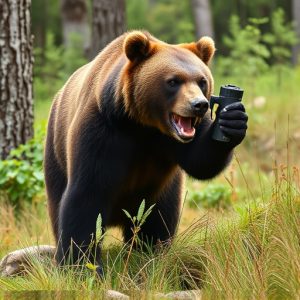Bear Spray Testing: Maximize Stopping Power with Safety Guidelines
Bear spray, a crucial tool for bear country safety, undergoes rigorous testing according to the Bear…….
Bear spray, a crucial tool for bear country safety, undergoes rigorous testing according to the Bear Spray Testing Safety Guidelines. These guidelines ensure product effectiveness while prioritizing user safety through controlled lab and field tests. Testing involves assessing spray range, concentration, and duration of immobilizing effects on mannequins or cadavers, verified by laboratory analyses. Safe use requires adhering to manufacturer instructions, regular maintenance, proper storage, and understanding application techniques, emphasizing responsible interactions during bear encounters.
“Unveiling the maximum stopping power of bear spray involves understanding its composition, effectiveness, and safety considerations. This article delves into these aspects, guiding you through essential testing methods and protocols. Learn about the unique properties of bear spray and discover practical tips to maximize its defensive potential. Additionally, explore critical safety guidelines for responsible use, ensuring both your protection and the preservation of wild habitats. Get ready to navigate encounters with confidence.”
- Understanding Bear Spray: Composition and Effectiveness
- Safety Considerations for Bear Spray Testing
- Testing Methods and Protocols
- Maximizing Stopping Power: Tips and Best Practices
Understanding Bear Spray: Composition and Effectiveness
Bear spray, also known as bear repellent, is a crucial tool for anyone venturing into bear country. Understanding its composition and effectiveness is key to ensuring its optimal use and safety. Typically, bear spray is a combination of capsaicin, a compound derived from chili peppers, and other ingredients like water, propylene glycol, and various preservatives. This potent mixture is designed to cause temporary but intense pain, irritation, and tear production in the eyes and nose of bears, creating a chance for escape or deterring an attack.
When it comes to bear spray testing and safety guidelines, several factors influence its effectiveness. These include the type of sprayer used, distance from the bear, weather conditions, and the bear’s behavior. It’s important to follow manufacturer instructions regarding usage, including recommended distances and spray patterns. Regular maintenance and proper storage are also essential to ensure the spray remains potent over time. Bear spray testing often involves controlled scenarios in labs or field tests, which help evaluate its stopping power while adhering to safety protocols.
Safety Considerations for Bear Spray Testing
When testing bear spray, safety considerations should be at the forefront of every step. Always conduct tests in a controlled and safe environment, preferably outdoors with adequate space and minimal risk to bystanders. It’s crucial to wear protective gear, including eye protection and thick gloves, as bear spray can cause severe irritation or damage when direct contact is made. Ensure proper ventilation to avoid inhalation of the spray mist, which can be hazardous to your health.
Follow established safety guidelines for handling bear spray, such as keeping a safe distance from the testing area and ensuring no pets or vulnerable individuals are present. Use approved testing methods and equipment to accurately measure the spray’s range, concentration, and effectiveness without compromising safety. Remember that bear spray testing is not just about evaluating its power; it’s also about understanding its limitations and ensuring responsible use in real-life scenarios.
Testing Methods and Protocols
Bear spray testing involves rigorous protocols designed to assess its effectiveness and safety under various conditions. These tests are conducted according to established Bear Spray Testing Safety Guidelines, ensuring that products meet specific performance criteria before market release. Methodologies may include simulated encounters with bear mannequins or cadavers, evaluating spray range, concentration, and duration of immobilizing effects.
Additionally, laboratory analyses can measure the spray’s chemical composition and stability over time, ensuring the product retains its maximum stopping power. All testing should be conducted in controlled environments by trained professionals to guarantee both accuracy and the safety of personnel involved.
Maximizing Stopping Power: Tips and Best Practices
Maximizing the stopping power of bear spray involves understanding and adhering to key safety guidelines and best practices. First, always ensure proper training and certification in using bear spray before heading into potential bear country. Knowing the right distance, angle, and duration of spray application can significantly enhance its effectiveness. Practice regular bear spray testing to familiarize yourself with the product’s performance under various conditions.
Additionally, maintaining a clean and well-maintained sprayer is crucial. Inspect your sprayer for any damage or blockages before each trip, ensuring the nozzle is clear and the can is fully charged. Bear spray should be stored in a cool, dry place to prevent degradation of its components. Following these testing safety guidelines will not only optimize the stopping power but also ensure a safer experience during encounters with bears.
Bear spray, when used correctly, can be a powerful defense against bear encounters. Understanding its composition, effectiveness, and safety considerations is crucial. Adhering to rigorous testing protocols ensures optimal performance. By following best practices and safety guidelines for bear spray testing, individuals can maximize their stopping power and enhance their chances of staying safe in bear country.


